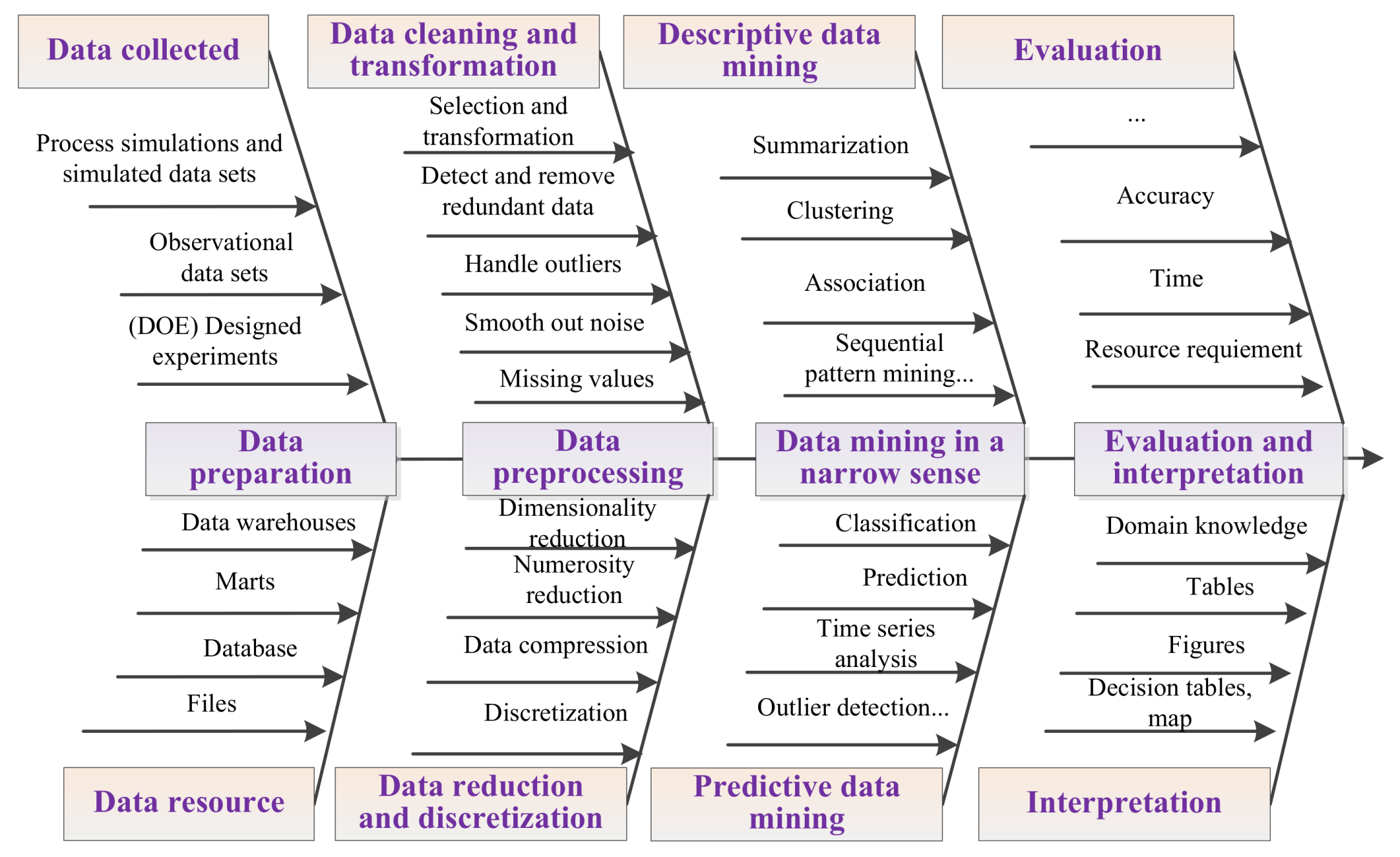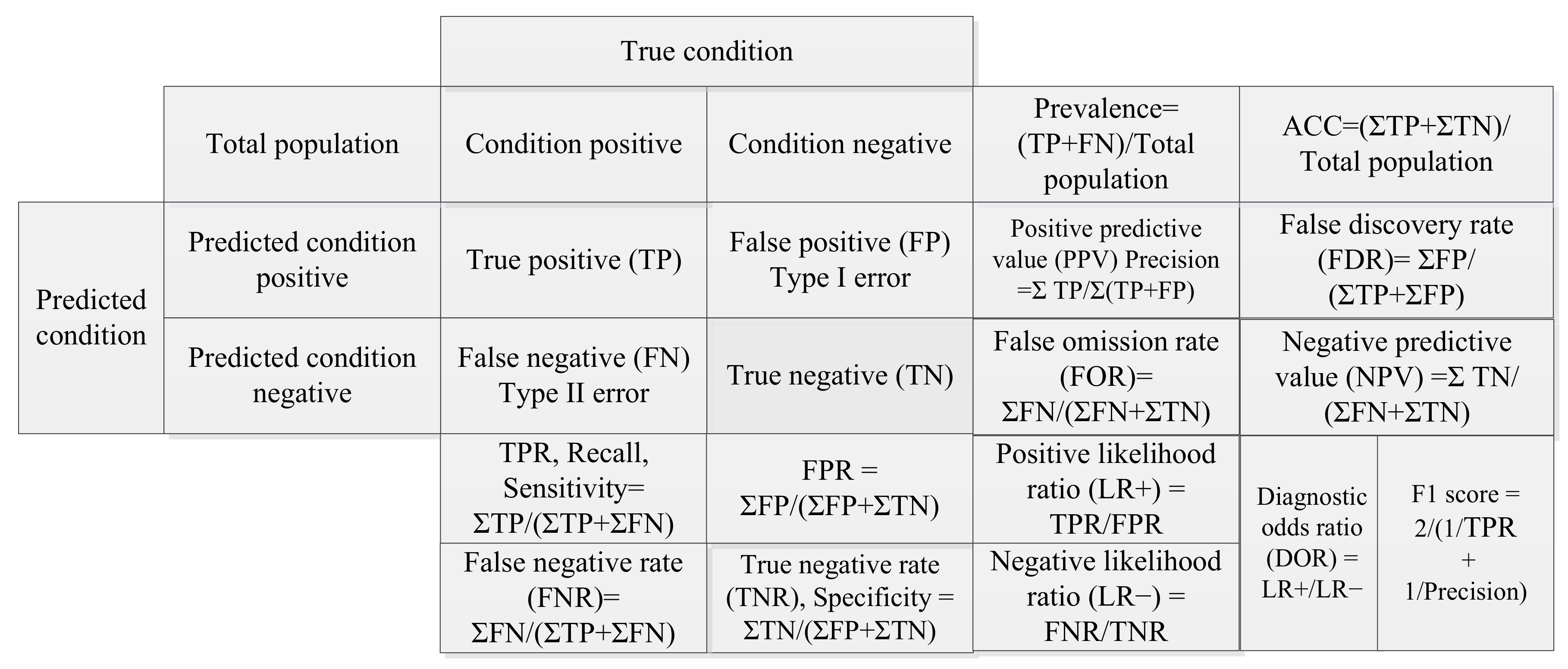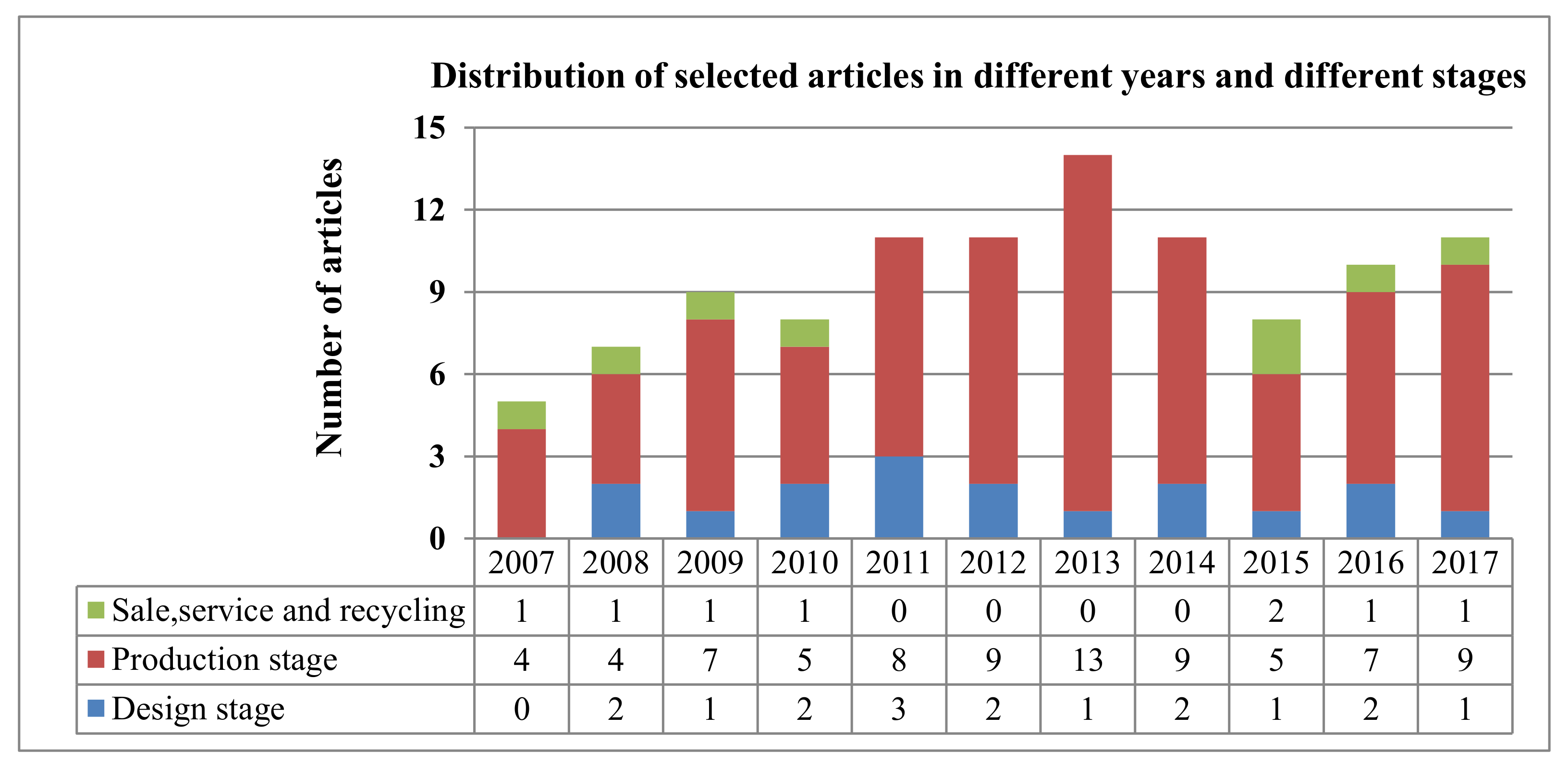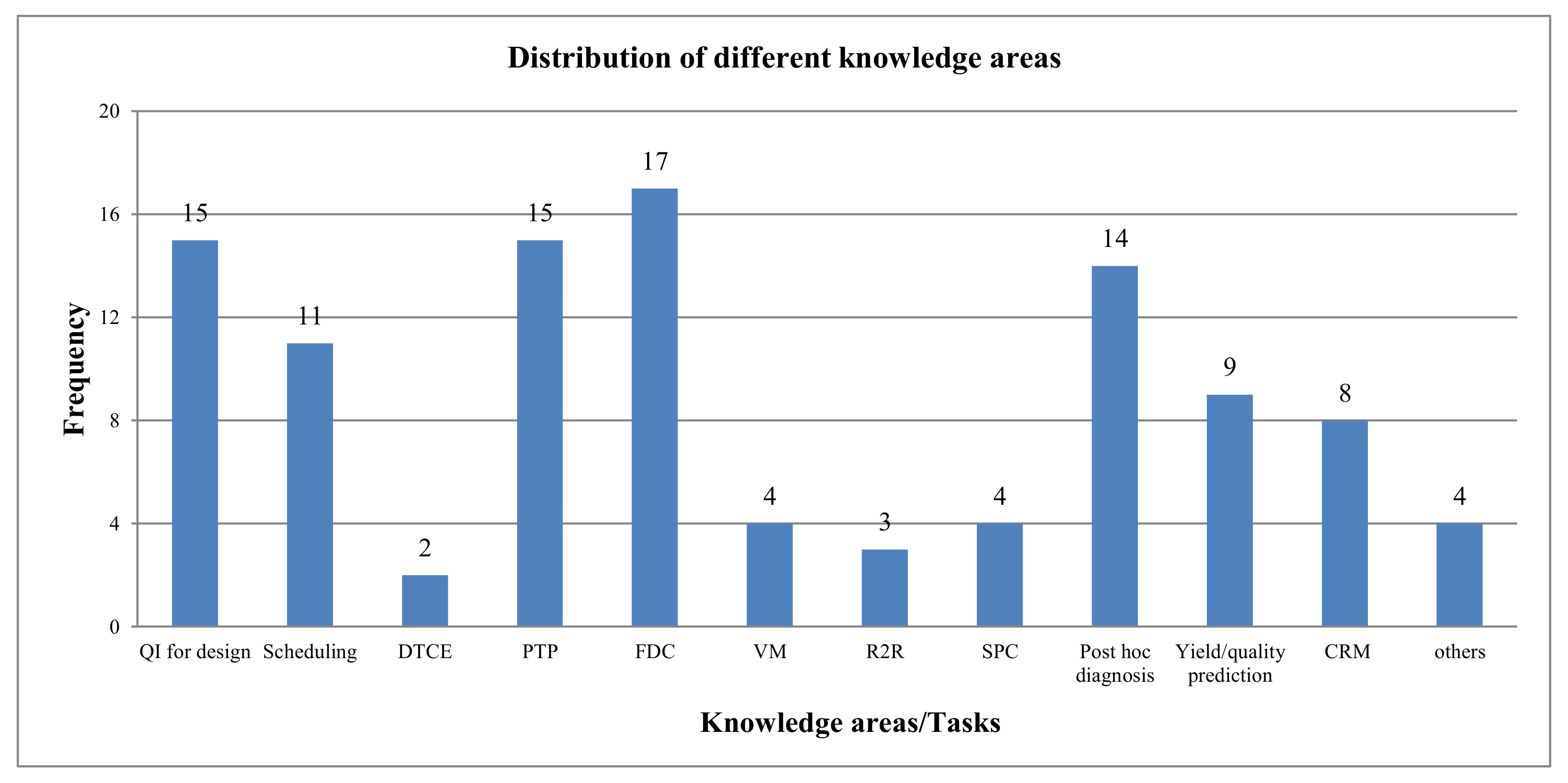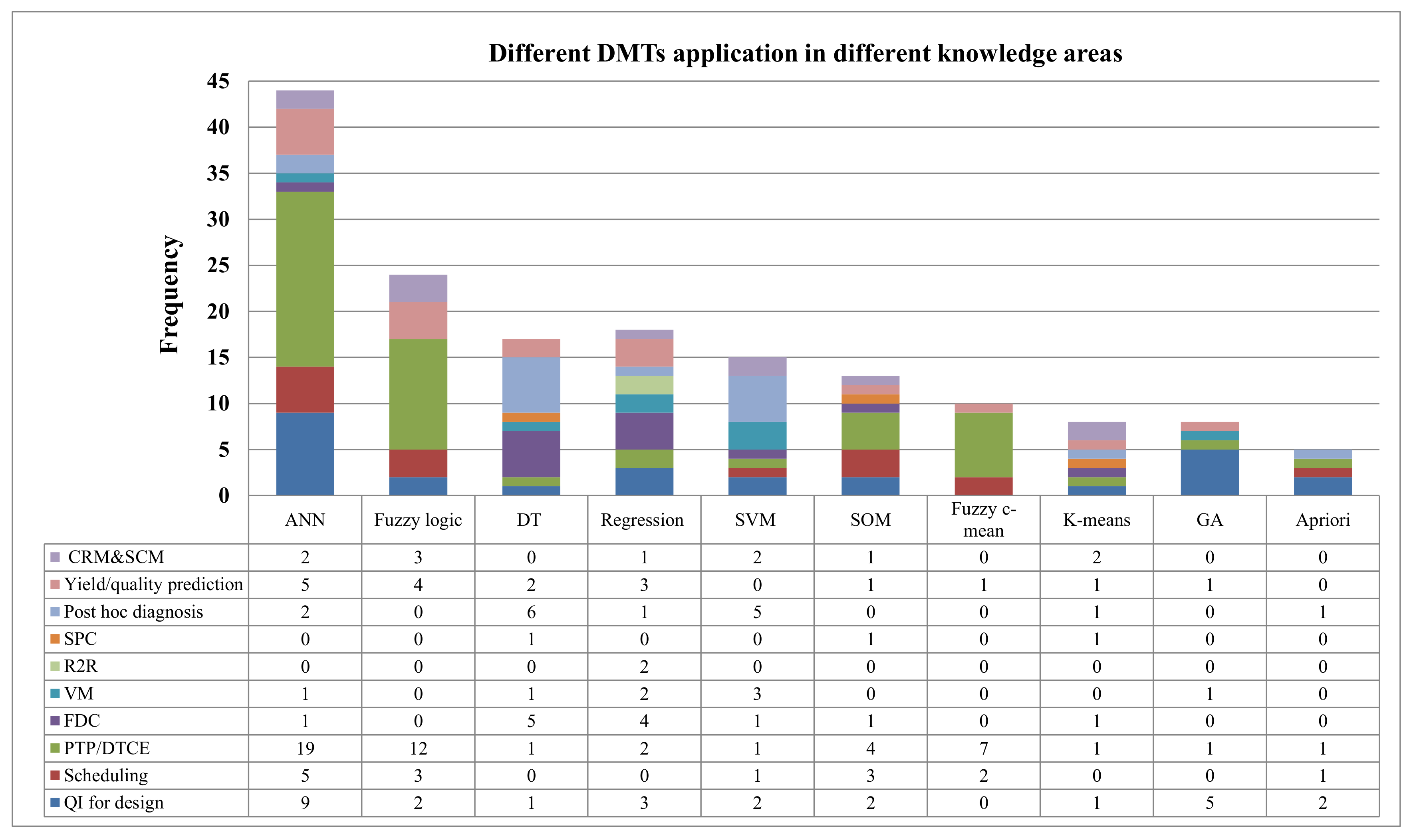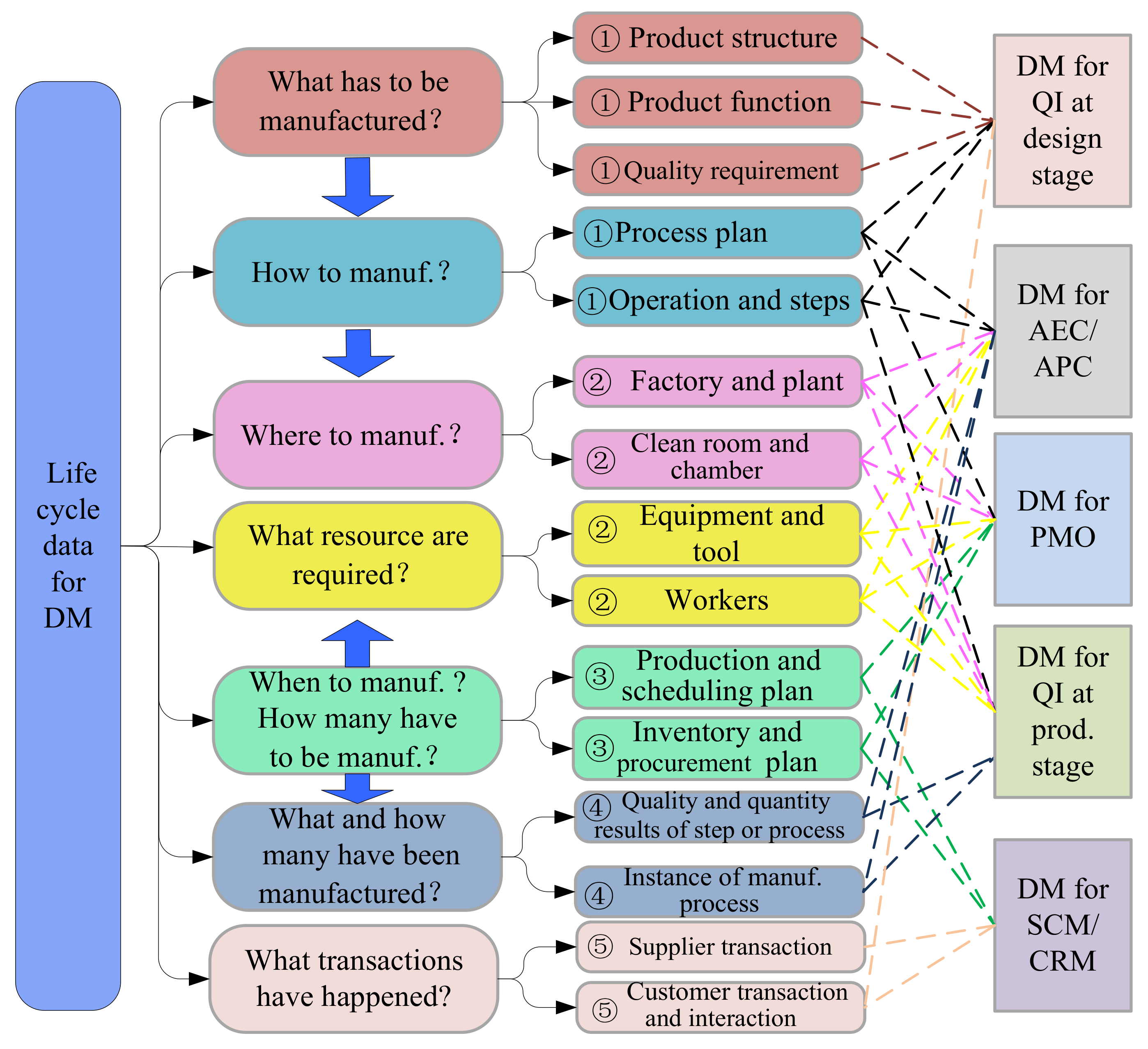1. Introduction
Since the internet of things and advanced information technologies (for example, radio frequency identification (RFID) tags and smart sensors) are widely used in manufacturing enterprises for their daily production and management, the product lifecycle management (PLM) processes produce a huge amount of data [
1]. Furthermore, the accumulation of historical data in enterprise resource planning (ERP), supply chain management (SCM), customer relationship management (CRM), and order management system (OMS), as well as the timely collected data by the widely used manufacturing execution system (MES) and distributed control system (DCS) contributed to the sharp increase of data over the decades. The era of industrial Big Data has come.
Leaders of manufacturing enterprises are becoming increasingly interested in benefiting their companies by effectively using Big Data [
1]. Big data related technologies such as knowledge discovery in databases (KDD) and data mining (DM) have been widely employed to enhance the intelligence and efficiency of the design, production, and service processes in many manufacturing scenes such as product design improvement, manufacturing process optimization, production management and optimization (PMO), production process monitoring and control, quality management, CRM, SCM, and so forth. Intel employs Big Data for predictive maintenance of equipment and greatly reduces the unnecessary equipment stop and idle time. A Taiwan Semiconductor Manufacturing Company adopts Big Data based advanced equipment control/advanced process control (AEC/APC) to improve production efficiency and wafer yield. Many reviews of these applications in the manufacturing industry have been reported and summarized in
Table 1, from which we can see most of the achievements related to DM application in manufacturing before 2015 [
2,
3,
4,
5,
6], and many researchers have started to adopt the concept of Big Data [
7,
8,
9,
10,
11] in smart manufacturing since then. However, the aforementioned reviews provide no comprehensive analysis of DM with Big Data nor a summarization of them in the electronics industry from the view of their lifecycle, considering the special requirement of this manufacturing industry to the best of our knowledge.
Electronics is one of the fastest evolving, most innovative, and most competitive industries. The research and development of new and improved products are of great importance, where companies often compete fiercely to bring the newest technology to the market first. The past five years, from 2012 to 2017, have been characterized by growth in emerging markets and introduction of new products, leading more people to buy consumer electronics. The global consumer electronics industry was valued at
$283 billion in 2015 [
12]. Grand view research predicted that the global consumer electronics market is expected to reach
$838.85 billion by 2020 [
13]. The newly developed products are featured by high precision, long and complex manufacturing/test processes with high purity environments, diverse and high-quality requirements from customers, and a large amount of data generated at different stages of their lifecycle from design and production to sale and service. Thus, the electronics industry is currently in the midst of a data-driven revolution [
7] which has pushed forward many data excavation related research over the past decades for the better utilization of these data that can facilitate quality or service improvement, production optimization, and so forth. [
14]. A review of DM with Big Data application in the electronics industry not only benefits researchers to develop strong research themes and identify gaps in the field but also helps practitioners for DM application system development.
In the following sections, DM with Big Data and related techniques are given in
Section 2 in which a brief introduction of the concepts of DM and Big Data is presented, and also the flowchart and the main content of the flowchart steps are summarized. In
Section 3, the article selection condition and distribution of the selected articles in different years and different lifecycle stages are discussed. A comprehensive analysis of the reviewed literature from various points of view is provided subsequently, in
Section 4, which summarizes data handling, discusses the DM with Big Data application in different stages of the product lifecycle, and surveys the software used in these applications. On this basis, the data content and a framework for DM application in the electronics industry are established in
Section 5. Finally, the conclusions and future research directions are given in
Section 6.
3. Article Selection and Distribution
The electronics industry is composed of organizations involved in the design, development, manufacture, assembly, and service of electronic equipment and components. These organizations offer a wide variety of products that range from government products, industrial products, consumer products, and electronic components as four primary segments. Each category serves a specific market, which allows it to focus on components and products geared toward their customers. The government market is primarily developed for aircraft and military products, as well as communication technology and medical devices. Industrial products include large-scale computers, radio and television broadcasting equipment, telecommunications equipment, and electronic office equipment, while consumer products are the well-known televisions, cell phones, DVD players, smartphones, radios, video game systems, personal computers, electronic ovens, and home intercommunication and alarm systems. The final segment the manufacturers produce and sell includes electron tubes, semiconductors, printed circuit boards (PCB), and passive components [
25].
Based on the initial search from databases with keywords such as DM, Big Data, and electronics, we found that most of the articles were related to consumer products and components. Therefore, articles related to DM with Big Data applications in consumer electronics and components were selected here. On this basis, the article selection was conducted in which the period of interest for this literature survey ranges from 2007 to 2017. In October 2017, a search was made according to the following conditions:
(1) Database: Science Direct, IEEE Xplore Digital Library, Springer Link, Taylor & Francis Online, Wiley Online Library, SAGE Journal, Web of Science, and Google Scholar
(2) Stages: design, production, sale, service, and recycling
(3) Products: electronic products, integrated circuit, wafer, semiconductor, PCB, phone, and computer
(4) DM-related concepts: data mining, Big Data, and knowledge discovery
(5) DM functions: Prediction, classification, clustering, association, product/process characterization, time series analysis, outlier detection, and anomaly detection.
A total of 105 application studies within the scope of this review were found. The distribution of the selected articles in different years and different stages are illustrated in
Figure 3. It can be seen that 17% (17 articles) were related to the stage of product and manufacturing process design [
26,
27,
28,
29,
30,
31,
32,
33,
34,
35,
36,
37,
38,
39,
40,
41,
42], and more than 75% (80 articles) applied DM and Big Data to production management and control in the stage of production [
43,
44,
45,
46,
47,
48,
49,
50,
51,
52,
53,
54,
55,
56,
57,
58,
59,
60,
61,
62,
63,
64,
65,
66,
67,
68,
69,
70,
71,
72,
73,
74,
75,
76,
77,
78,
79,
80,
81,
82,
83,
84,
85,
86,
87,
88,
89,
90,
91,
92,
93,
94,
95,
96,
97,
98,
99,
100,
101,
102,
103,
104,
105,
106,
107,
108,
109,
110,
111,
112,
113,
114,
115,
116,
117,
118,
119,
120,
121,
122], but less than 8% (8 articles) of applications focused on the stage of sale, service, and recycling [
123,
124,
125,
126,
127,
128,
129,
130]. The fluctuation in quantity of the selected articles in different years presents no obvious tendency, however, it indicates that the topic has attracted ongoing attention and research during the past decades, and the application areas have been extended and many new approaches have been developed.
5. Diagram of Data Content for Different Knowledge Areas and DM Framework for the Electronics Industry
The product lifecycle processes carry a huge number of structured, semi-structured, and unstructured data. Big Data analytics and DM technology can be used to make a deep analysis of historical lifecycle data, to discover knowledge, and to optimize the process of PLM. A framework with four modules including data sensing and acquisition, data processing and storage, DM model development, and Big Data application in PLM was presented by Zhang et al. [
1]. However, the summarization and classification of lifecycle related data and its utilization by different knowledge areas have not been discussed. Meanwhile, the special application scheme for electronics manufacturing has not been considered. Therefore, the establishment of a diagram of data content for different knowledge areas and DM with Big Data framework for the electronics industry can guide companies to accumulate related data and develop DM strategy from the view of lifecycle and overall business chain, which can also facilitate researchers and practitioners to select appropriate techniques and better utilization of data for knowledge discovery.
5.1. Diagram of Data Content for Different Knowledge Areas
From the view of electronics lifecycle, the main data for different knowledge areas can be divided into engineering data, enterprise resource and environment data, production plan and arrangement data, manufacturing result data, and transaction and interaction related data.
Figure 9 illustrates the main content of each category and its application for different knowledge areas. The detailed description of each category is given as follows.
① Engineering data: It includes product structure and function, manufacturing process plans, and quality requirements to define what is to be manufactured and how to manufacture. Relevant DM with Big Data applications have been conducted to improve product quality and customers’ satisfaction or to optimize process parameters. This data can be stored in different systems such as PLM and computer-aided process planning system with structured (bill of materials), semi-structured (requirement reports), and unstructured (design model or drawing) styles.
② Enterprise resource and environment data: Resource data relates to the workplace, equipment, and tools that specify where and what resource are required to manufacture the product, which also includes data on process statuses, collected in real time by smart sensors and the traced data based on RFID placed on transportation robots. In common, these data are structurally stored in ERP, MES, and DCS that can be used for the optimization of process control such as AEC/APC and production management. Taking an example from wafer fab, the equipment status data such as chamber pressure, gases flow, and chuck temperature are collected in real time by sensors placed on tools, and valuable data that are generated from clean room environment monitoring [
101].
③ Production plan and arrangement data: These data include the plan of the project, the hierarchy production plan, the inventory/material and procurement plan, and scheduling that defines when and how many products have to be manufactured. Different plans can be stored in ERP and MES with a structured style, which has been widely used for the optimization of PMO tasks such as production time prediction and scheduling optimization at the production stage.
④ Manufacturing result records: Result records define the quality and quantity of products at a certain time and workplace. They are always accumulated in MES, quality management system, ERP, and storage management system with a structured style. RFID has been widely used for product lifecycle management in recent years, and the traced data generated automatically at different stages through RFID placed on materials, semi-products, and finished products can also be taken as the data of manufacturing result. Taking an example from the data involved in the wafer fab, it is generated at various steps including inline through metrology steps that measure test wafers and product wafers such as parameters of critical dimension, film thicknesses, film resistances, and so forth. It also includes electrical test and final yield data. DM-based post hoc diagnosis, yield prediction, and parameters adjustment are used to ensure the future quality has been conducted based on different steps of the result. They can also be combined with enterprise resource and environment data for AEC/APC.
⑤ Interaction and transaction data: Owing to the fast development of online trading and electronic commerce in the past decades, a large amount of records related to transactions and online interactions between upper stream supplier, middle collaborator, downstream customer have been accumulated. The structured transaction data, semi-structured or unstructured interactions have been widely used for the optimization of SCM and CRM such as marketing analyses and product design improvement based on the feedback from customers at the design stage, procurement and inventory optimization at the production stage, price and demand prediction, customer identification, attraction, retention, and development at the SSR stage. Text mining techniques have also been used to excavate the pattern from the interaction text and were combined with DM for the final knowledge discovery [
123]. Meanwhile, RFID-based records can be used for product tracing in transaction, service, and recycling.
5.2. Data Mining with Big Data Frameworks for the Electronics Industry
On the basis of the aforementioned review, a framework of DM with Big Data applications in the electronics industry is presented in
Figure 10 in which the stage of design and production corresponds to the beginning of lifecycle, and the sale and service can be taken as the middle of lifecycle, while recycling is at the end of lifecycle, respectively [
1,
8].
Each stage of the lifecycle corresponds to different application scenes. The DM application of product and manufacturing process design mainly includes the product design, manufacturing process design, and marketing with relevant knowledge areas, such as quality improvement, development cost and time prediction, product customization, manufacturing parameter optimization, and SCM. The equipment management, production management, and procurement are the main application areas of DM with Big Data in the production stage with typical knowledge areas such as AEC/APC, PMO, QI, and SCM. The application of the DM with Big Data for sale and service cannot only be support for quality improvement and customization design but also optimize logistics and facilitate customer service and maintenance. The recycling attracted less attention from DM with Big Data application in the electronics industry, which could be used in remanufacturing, reuse, and environment protection, considering the knowledge areas of product recovery, remaining life prediction, and reverse logistics optimization.
The details of knowledge areas of different stages have been summarized in
Section 4.2. The quality improvement for design and production can be further divided into quality (yield) prediction, classification, description, and parameter optimization. Post hoc diagnosis can be taken as the quality description at the production stage with the purpose of process parameters adjustment to ensure future quality. The tasks of AEC/APC that consists of FDC, R2R control, SPC, VM, and so forth are also for quality enhancement, and therefore, the quality improvement at the production stage and AEC/APC are not a disjoint division here. The DM and Big Data application in PMO is a collection of scheduling optimizations, cost/time prediction, and so on.
SCM is used to optimize the logistics for material supply at the beginning stage of the lifecycle and it can also be used to achieve greater efficiencies and effectiveness in delivering customer value at the end of the lifecycle. The application of DM or Big Data tools in CRM is an emerging trend in the global economy. Analyzing and understanding customer behaviors and characteristics is the foundation of the development of a competitive CRM strategy so as to acquire and retain potential customers and maximize customer value [
3]. The tasks of customer identification, attraction, retention, and development of CRM can be realized through Big Data-based marketing prediction, personalized service, predictive maintenance, remote online diagnosis and so on.
Data preparation such as data acquisition, accumulation, and storage for different knowledge areas and applications can be guided by the diagram of data content for different knowledge areas given in
Section 5.1. The commonly used data preprocessing techniques including data cleaning, transformation, reduction, and discretization that can utilize the preprocessing approaches summarized in
Section 2.2 and
Section 4.1, based on the requirement of application areas and the quality of data. DM, in a narrow sense, for each function, can be implemented based on some pervasive DMTs summarized in
Section 4.2.4. The interpretation, evaluation, and implementation software can be conducted by combing experts’ knowledge with performance indicators given in
Section 2.4, which is not given in the framework because it has many selections in practice. The final purpose of the DM application has been proved by many researchers and practitioners. This framework provides an option for different types of companies and expects for further extension.
6. Conclusions and Future Research Directions
This paper presents a comprehensive review of DM with Big Data towards its applications in the electronics industry. We can see that the DM with Big Data has been applied to different scenes including product design improvement, manufacturing process optimization, PMO, production process monitoring and control, quality improvement, CRM, and so forth.
Customer-oriented product development and process plan optimization are the main applications for product design improvement and manufacturing process optimization in the stage of design. Prediction was the most frequently used DM function observed in the reviewed articles. ANN and regression were the widely used DMTs for the prediction.
The application of DM with Big Data for process monitoring and control, PMO, and quality improvement in the stage of production has attracted the interest of most research. On the one hand, sophisticated DM and Big Data related techniques such as FDC and R2R have been developed for the wafer production process monitoring and control to reduce defects and improve the quality/yield based on the data collected from manufacturing processes, equipment/tool/environment statuses, and process parameters. The functions of classification and clustering were widely used for FDC based on related DMTs such as DT, SVM and ANN, k-means and SOM, while the prediction function was widely presented for VM based on ANN, regression, and SVM. On the other hand, prediction, clustering, and the combination of the two are the most frequently employed functions for the optimizing scheduling plan and prediction of cycle time/due date based on ANN, FCM, SOM, and a hybrid of fuzzy logic and ANN. Additionally, post hoc diagnosis, quality prediction, and classification were conducted based on the functions of prediction, classification, clustering, and association for future production quality improvement.
Most of the DM applications are related to CRM at the stage of SSR for the purpose of acquiring and retaining potential customers and maximizing customer value based on the records of transaction and online feedback from customers. Prediction, classification, clustering, and time series analysis functions were conducted based on ANN, regression, and SVM for sale and service to mine the consumption habits and predict the marketing price.
The achievement of the reviewed articles facilitates theoretical study and practical application of DM with Big Data to the electronics industry. Nevertheless, the limitation and challenges still exist for future research.
(1) Data preparation and preprocessing. The data of the product lifecycle are characterized by multisource (for example, design, production, and service data), heterogeneity (for example, structured, semi-structured, and unstructured data), and “noise” (for example, incomplete, incorrect, redundant, and inconsistent data) [
1]. These problems increase the difficulties of data preparation, preprocessing, and subsequent mining, and also generate misleading patterns. However, little effort has been devoted to handling these problems. Manufacturing organizations with well-established and integrated data collection systems would benefit from a larger application of DM and Big Data [
4]. Unified management and storage of the multi-source and heterogeneous data are necessary, and this motivates enterprises to develop DM strategies with dedicated consideration to data accumulation, integration, and consistency. Multi-business requirements integration, concept standardization, unified model establishment, and data/system interface development should be conducted collaboratively to facilitate data utilization. The standardization of operations such as data entry, storage, and maintenance should also be conducted accordingly to ensure the data quality and reduce data redundancy.
(2) The knowledge area of DM application. DM has been widely used in the stage of design and production especially for wafer fab and PCB assembly, and the pervasive knowledge areas include QI, PMO, AEC/APC, and so forth. However, potential applications such as customization production, procurement, warehouse management and inventory balance, and equipment maintenance and repair require more relevant data accumulation and extended mining. The global logistics industry has a large ever-growing amount of Big Data and is flooded with real-time data ranging from smartphones, sensors, and digital machines [
9]. However, the application of DM with Big Data in SCM and logistics for electronic products has attracted few special discussions. Meanwhile, little effort has been put on CRM and order management combining the features of electronics such as a large amount of consumers, fast replacement of new products, and fierce market competition.
The patterns and knowledge hidden in Big Data are multidimensional (for example, various departments and lifecycle stages) and scattered, which hinders the effective mining and utilization of the knowledge. Therefore, further studies can be conducted to mine consumer habits and market characteristics to support more reasonable decision for customization product development, market pricing, and maintenance based on the association, prediction, and time series analysis functions. The fast upgrading of electronic products resulting in a large number of e-waste and the use of DM and Big Data to improve the efficiency and effectiveness of its energy saving, recycling, reverse logistics, and reduction of environmental risks are a worthwhile attempt. More importantly, the macro strategy for integrated mining and integration applications for the whole lifecycle should be considered and developed by enterprises.
(3) DM functions and DMTs. The prediction, classification, and clustering are the most frequently used DM functions while the other three functions (outlier detection, association and time series analysis) have been used only in a few situations. The extended investigation of outlier detection, sequential pattern mining, and time series analysis considering time information for online model development and updating could enable companies to respond promptly to dynamic and emerging situations. For DMTs, the parameter optimization of DMTs, such as ANN and SVM, requires continuous study. While FCM and fuzzy logic have been combined with ANN to handle uncertainty, they might be combined with other related mechanisms such as SVM and regression. Additionally, these approaches would handle Big Data with easy implementation and high performance, and more deliberate consideration for industrial applications is required.
(4) Algorithm performance. In general, it is difficult to obtain results with obviously competitive advantage in the existing single algorithm. Generally, a hybrid mining algorithm needs to be constructed based on the characteristics of the problem by integrating different functions and different DMTs so as to ensure the validity and advantage of the algorithm. How to set and optimize algorithm parameters, such as parameters of ANN and SVM, also remains to be further studied. Meanwhile, how to evaluate the advantages and disadvantages of the developed algorithm dynamically and ensure the robustness of the algorithm under certain data loss and redundancy needs to be further compared. How to evaluate the under-fitting and overfitting of algorithms and balance of the two has been paid less attention and requires further consideration.
(5) Software and implementation: Many researchers employed special purpose tools, such as NeuroSolutions, Neural Network Toolbox, LibSVM, Fuzzy Logic Toolbox, and SOM toolbox to implement the developed algorithms. Meanwhile, many approaches were developed by Matlab. A dedicated software package and Matlab integration of the basic engine allowed researchers to implement the proposed algorithm and verify the results more easily. The FDC was always conducted based on online analysis related platforms that were developed independently because of its high-efficiency requirements for data preprocessing and algorithm execution. However, application-oriented software platforms, such as Orange, IBM SPSS modeler, WEKA, and RapidMiner were employed only by few researchers in the reviewed articles. In order to strengthen the connection between enterprises and research, one of the important directions is to directly develop the application platform and then, to validate and optimize the results through practical feedback. In addition, DM technology should be combined with data management and visualization tools that can facilitate user understanding, operating, and utilizing data efficiently.
(6) Knowledge maintenance and updating. Most of the mining was conducted statically and the corresponding data handling was conducted based on batch data. These approaches were difficult to learn by themselves and the patterns obtained were often difficult to update dynamically based on newly accumulated data. Nowadays, data is generated continuously and typically sent in the data records simultaneously and in small sizes. This data needs to be processed sequentially and incrementally on a record-by-record basis or over sliding time windows and also used for a wide variety of analytics and mining. Online mining and learning will be an important challenge for further research.
